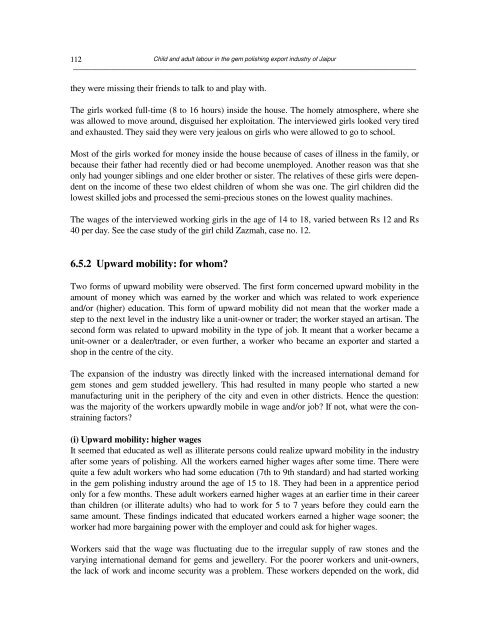Create successful ePaper yourself
Turn your PDF publications into a flip-book with our unique Google optimized e-Paper software.
112<br />
<strong>Child</strong> <strong>and</strong> <strong>adult</strong> <strong>labour</strong> <strong>in</strong> <strong>the</strong> <strong>gem</strong> polish<strong>in</strong>g <strong>export</strong> <strong>in</strong>dustry <strong>of</strong> Jaipur<br />
──────────────────────────────────────────────────────────────────────────────────────────────<br />
<strong>the</strong>y were miss<strong>in</strong>g <strong>the</strong>ir friends to talk to <strong>and</strong> play with.<br />
The girls worked full-time (8 to 16 hours) <strong>in</strong>side <strong>the</strong> house. The homely atmosphere, where she<br />
was allowed to move around, disguised her exploitation. The <strong>in</strong>terviewed girls looked very tired<br />
<strong>and</strong> exhausted. They said <strong>the</strong>y were very jealous on girls who were allowed to go to school.<br />
Most <strong>of</strong> <strong>the</strong> girls worked for money <strong>in</strong>side <strong>the</strong> house because <strong>of</strong> cases <strong>of</strong> illness <strong>in</strong> <strong>the</strong> family, or<br />
because <strong>the</strong>ir fa<strong>the</strong>r had recently died or had become unemployed. Ano<strong>the</strong>r reason was that she<br />
only had younger sibl<strong>in</strong>gs <strong>and</strong> one elder bro<strong>the</strong>r or sister. The relatives <strong>of</strong> <strong>the</strong>se girls were dependent<br />
on <strong>the</strong> <strong>in</strong>come <strong>of</strong> <strong>the</strong>se two eldest children <strong>of</strong> whom she was one. The girl children did <strong>the</strong><br />
lowest skilled jobs <strong>and</strong> processed <strong>the</strong> semi-precious stones on <strong>the</strong> lowest quality mach<strong>in</strong>es.<br />
The wages <strong>of</strong> <strong>the</strong> <strong>in</strong>terviewed work<strong>in</strong>g girls <strong>in</strong> <strong>the</strong> age <strong>of</strong> 14 to 18, varied between Rs 12 <strong>and</strong> Rs<br />
40 per day. See <strong>the</strong> case study <strong>of</strong> <strong>the</strong> girl child Zazmah, case no. 12.<br />
6.5.2 Upward mobility: for whom?<br />
Two forms <strong>of</strong> upward mobility were observed. The first form concerned upward mobility <strong>in</strong> <strong>the</strong><br />
amount <strong>of</strong> money which was earned by <strong>the</strong> worker <strong>and</strong> which was related to work experience<br />
<strong>and</strong>/or (higher) education. This form <strong>of</strong> upward mobility did not mean that <strong>the</strong> worker made a<br />
step to <strong>the</strong> next level <strong>in</strong> <strong>the</strong> <strong>in</strong>dustry like a unit-owner or trader; <strong>the</strong> worker stayed an artisan. The<br />
second form was related to upward mobility <strong>in</strong> <strong>the</strong> type <strong>of</strong> job. It meant that a worker became a<br />
unit-owner or a dealer/trader, or even fur<strong>the</strong>r, a worker who became an <strong>export</strong>er <strong>and</strong> started a<br />
shop <strong>in</strong> <strong>the</strong> centre <strong>of</strong> <strong>the</strong> city.<br />
The expansion <strong>of</strong> <strong>the</strong> <strong>in</strong>dustry was directly l<strong>in</strong>ked with <strong>the</strong> <strong>in</strong>creased <strong>in</strong>ternational dem<strong>and</strong> for<br />
<strong>gem</strong> stones <strong>and</strong> <strong>gem</strong> studded jewellery. This had resulted <strong>in</strong> many people who started a new<br />
manufactur<strong>in</strong>g unit <strong>in</strong> <strong>the</strong> periphery <strong>of</strong> <strong>the</strong> city <strong>and</strong> even <strong>in</strong> o<strong>the</strong>r districts. Hence <strong>the</strong> question:<br />
was <strong>the</strong> majority <strong>of</strong> <strong>the</strong> workers upwardly mobile <strong>in</strong> wage <strong>and</strong>/or job? If not, what were <strong>the</strong> constra<strong>in</strong><strong>in</strong>g<br />
factors?<br />
(i) Upward mobility: higher wages<br />
It seemed that educated as well as illiterate persons could realize upward mobility <strong>in</strong> <strong>the</strong> <strong>in</strong>dustry<br />
after some years <strong>of</strong> polish<strong>in</strong>g. All <strong>the</strong> workers earned higher wages after some time. There were<br />
quite a few <strong>adult</strong> workers who had some education (7th to 9th st<strong>and</strong>ard) <strong>and</strong> had started work<strong>in</strong>g<br />
<strong>in</strong> <strong>the</strong> <strong>gem</strong> polish<strong>in</strong>g <strong>in</strong>dustry around <strong>the</strong> age <strong>of</strong> 15 to 18. They had been <strong>in</strong> a apprentice period<br />
only for a few months. These <strong>adult</strong> workers earned higher wages at an earlier time <strong>in</strong> <strong>the</strong>ir career<br />
than children (or illiterate <strong>adult</strong>s) who had to work for 5 to 7 years before <strong>the</strong>y could earn <strong>the</strong><br />
same amount. These f<strong>in</strong>d<strong>in</strong>gs <strong>in</strong>dicated that educated workers earned a higher wage sooner; <strong>the</strong><br />
worker had more barga<strong>in</strong><strong>in</strong>g power with <strong>the</strong> employer <strong>and</strong> could ask for higher wages.<br />
Workers said that <strong>the</strong> wage was fluctuat<strong>in</strong>g due to <strong>the</strong> irregular supply <strong>of</strong> raw stones <strong>and</strong> <strong>the</strong><br />
vary<strong>in</strong>g <strong>in</strong>ternational dem<strong>and</strong> for <strong>gem</strong>s <strong>and</strong> jewellery. For <strong>the</strong> poorer workers <strong>and</strong> unit-owners,<br />
<strong>the</strong> lack <strong>of</strong> work <strong>and</strong> <strong>in</strong>come security was a problem. These workers depended on <strong>the</strong> work, did


















